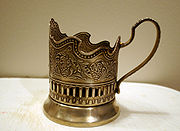
Podstakannik
Encyclopedia

Post-Soviet states
The post-Soviet states, also commonly known as the Former Soviet Union or former Soviet republics, are the 15 independent states that split off from the Union of Soviet Socialist Republics in its dissolution in December 1991...
.
Podstakanniks appeared in Russian tea culture in the late 18th century, when drinking tea became common in Russia. Very soon podstakanniks became not just practical utensils, but also works of art, just like samovar
Samovar
A samovar is a heated metal container traditionally used to heat and boil water in and around Russia, as well as in other Central, South-Eastern, Eastern European countries,Kashmir and in the Middle-East...
s that were used for boiling water. Expensive podstakanniks for the rich and the elite were made of silver
Silver
Silver is a metallic chemical element with the chemical symbol Ag and atomic number 47. A soft, white, lustrous transition metal, it has the highest electrical conductivity of any element and the highest thermal conductivity of any metal...
, however they were not very practical, since they would get quite hot very quickly due to the high thermal conductivity
Thermal conductivity
In physics, thermal conductivity, k, is the property of a material's ability to conduct heat. It appears primarily in Fourier's Law for heat conduction....
of silver.
By the 20th century podstakanniks became very widespread. In the Soviet Union
Soviet Union
The Soviet Union , officially the Union of Soviet Socialist Republics , was a constitutionally socialist state that existed in Eurasia between 1922 and 1991....
they were made mostly from nickel silver
Nickel silver
Nickel silver, also known as German silver, Argentann, new silver, nickel brass, albata,, or alpacca, is a copper alloy with nickel and often zinc. The usual formulation is 60% copper, 20% nickel and 20% zinc. Nickel silver is named for its silvery appearance, but it contains no elemental silver...
, cupronickel
Cupronickel
Cupronickel or copper-nickel or "cupernickel" is an alloy of copper that contains nickel and strengthening elements, such as iron and manganese. Cupronickel is highly resistant to corrosion in seawater, because its electrode potential is adjusted to be neutral with regard to seawater...
, and other alloys with nickel
Nickel
Nickel is a chemical element with the chemical symbol Ni and atomic number 28. It is a silvery-white lustrous metal with a slight golden tinge. Nickel belongs to the transition metals and is hard and ductile...
, silver
Silver
Silver is a metallic chemical element with the chemical symbol Ag and atomic number 47. A soft, white, lustrous transition metal, it has the highest electrical conductivity of any element and the highest thermal conductivity of any metal...
, or gold
Gold
Gold is a chemical element with the symbol Au and an atomic number of 79. Gold is a dense, soft, shiny, malleable and ductile metal. Pure gold has a bright yellow color and luster traditionally considered attractive, which it maintains without oxidizing in air or water. Chemically, gold is a...
plating. Though in modern times, simple tea cups or mugs are typically used by Russians at home, podstakanniks continue to be widely used for serving tea on the Russian Railways
Russian Railways
The Russian Railways , is the government owned national rail carrier of the Russian Federation, headquartered in Moscow. The Russian Railways operate over of common carrier routes as well as a few hundred kilometers of industrial routes, making it the second largest network in the world exceeded...
, since they provide more safety while drinking or carrying tea on a moving train.
Most Russian tea glass holders have been produced by a plant located in Kolchugino
Kolchugino
Kolchugino is a town in Vladimir Oblast, Russia, located on the Peksha River some northwest of Vladimir. Population:...
, Vladimir Oblast
Vladimir Oblast
Vladimir Oblast is a federal subject of Russia . Its administrative center is the city of Vladimir, which is located east of Moscow...
, which continues to be the main glass holder producer to this day. Some podstakanniks depict architecture, famous people, famous dates in history, cities of USSR, etc., giving a good general survey of Russian and Soviet history.
See also
- TeaTeaTea is an aromatic beverage prepared by adding cured leaves of the Camellia sinensis plant to hot water. The term also refers to the plant itself. After water, tea is the most widely consumed beverage in the world...
- Tea culture
- Подстаканник Russian Wikipedia gallery
- ZarfZarfA Zarf is a holder, usually of ornamental metal, for a coffee cup without a handle .-History:Although coffee was probably discovered in Ethiopia, it was in Turkey at around the thirteenth century that it became popular as a beverage. As with the serving of tea in China and Japan, the serving of...
External links
- All about podstakanniks at podstakannik.ru
- Tea Cultural References

